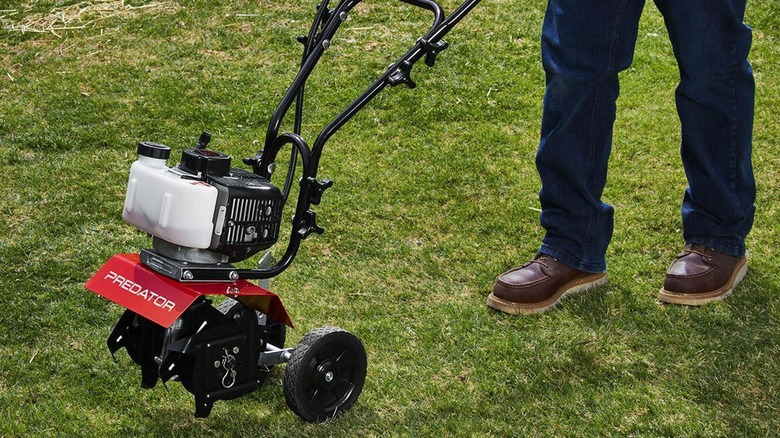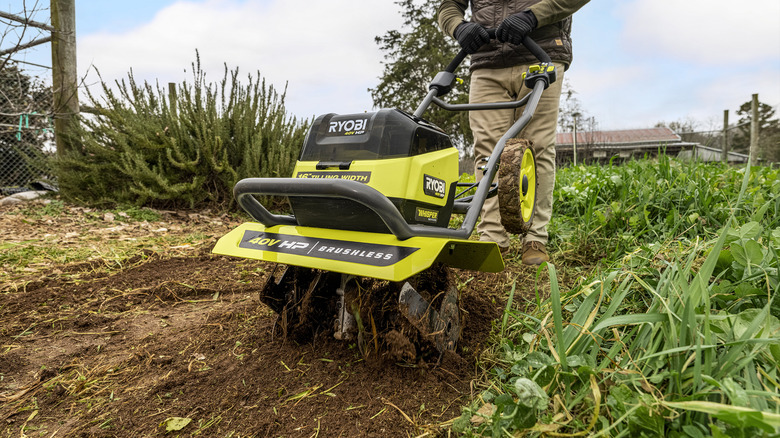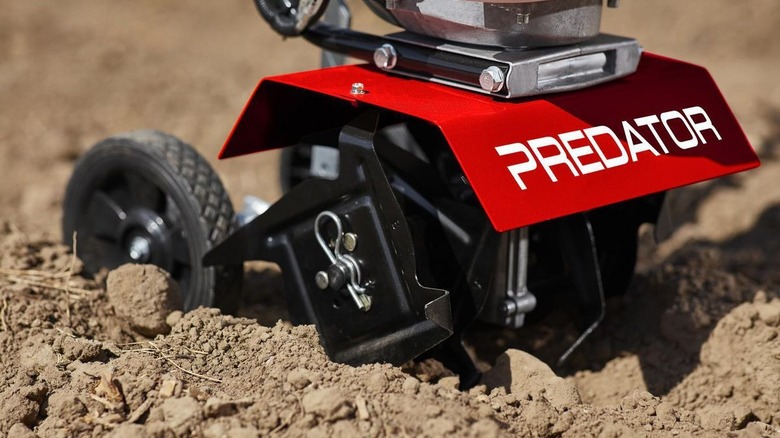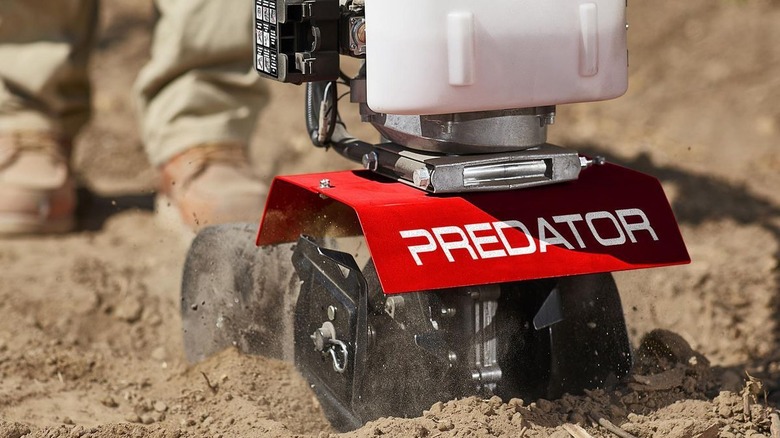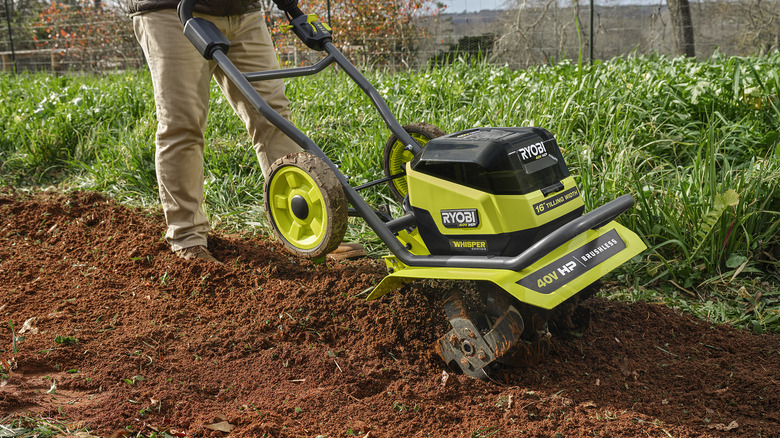Harbor Freight's Cultivator Vs. Ryobi's Front Tine Tiller: What's The Difference?
We may receive a commission on purchases made from links.
Gardening is a relaxing and productive activity. You get to watch the fruits of your hard work on a patch of land, sometimes literally if you're growing produce. The only thing is that the tools you would need for gardening can vary depending on the scope of your gardening pursuits. If you were just tending a small patch of soil in a corner of your backyard, you could handle the whole thing with a shovel and a trowel. If, however, you're managing entire lines of soil full of seeds, the tools you need would need to grow proportionally in size and strength.
If you visit your local Harbor Freight hardware store for more powerful gardening tools, you may stumble upon the 2-stroke gas cultivator from one of the store's in-house brands, Predator. However, if you were to look for something similar at a Home Depot, you may have noticed the 16-inch front tine tiller from Ryobi. At a casual glance, these two tools seem similar, as they're both pushable devices with rotating blades along the bottom. In actuality, though, cultivators and tillers are very different tools with specific purposes, which means if you buy the Predator cultivator or Ryobi tiller for the wrong purpose, you may have a problem.
What is a tiller used for?
Running a garden isn't as simple as shoving a bunch of seeds into the first patch of dirt you see. Ordinary dirt that's been trodden upon by all manners of people and critters has been too densely compacted to properly receive air and water from the world around it. That's assuming it's even dirt at all, which includes clay, sand, or silt.
If you've got a patch of land you want to turn into a garden that's too packed to hold seeds, that's when you bust out the tiller. A tiller is a large, heavy-duty tool designed to forcefully dig its tines into the ground and rip up the packed dirt as you push it. These tines are large in size and thick in composition, so they can not only tear up old dirt into workable soil but also move aside obstructions like old plants and pebbles. Since shoving blades through old dirt is a bit of a difficult task, tillers are usually powered by gas or batteries in addition to your personal pushing. The extra propulsion strength helps you to make consistent headway into a new plot of land so you're not standing out there all day.
What is a cultivator?
Even after you've broken up that tightly packed dirt with a tiller, it might not be quite ready for planting. Even after you've loosened it up, if it hasn't played host to life already, then there's nothing in there to foster more of it. A plant can't nourish itself on just dirt; it needs organic matter to promote plant growth. If you're really planning on going all-in on the gardening lifestyle, that's when you need to put the tiller away and bust out its more precise sibling, the cultivator.
A cultivator's job is to run its tines through soil that's already been loosened a bit in order to dice it up even further, as well as mix organic substances like compost and fertilizer into your garden to foster plant growth. Cultivators are not strong enough to handle the same kind of unbroken land that a tiller can, but they're great at chopping up the soil into an even softer, finer state. If you've got soil that's already been through a few harvests and needs a bit of freshening up, the cultivator will mix things up and get it ready for prime time again. Cultivators generally have a smaller digging depth than tillers, lending themselves better to day-to-day gardening work.
Harbor Freight cultivator specs
If you're in the market for a tiller, you won't find that at Harbor Freight, unfortunately. However, if it's a cultivator you want, then it does have that. Specifically, the 2-stroke gas cultivator. This tool is part of the Predator brand, Harbor Freight's in-house brand specializing in engine-powered implements like generators, power washers, and heavy garden tools.
The Harbor Freight cultivator utilizes a 43cc 2-stroke gas-powered engine to deliver a reliable amount of power without getting too carried away. Just fill the tank, squeeze the handlebar-mounted controller, give it a push, and you're off to the races. With a set of bidirectional shredding tines on the bottom, this cultivator is designed to mix and aerate existing soil. The tines are made of hardened steel, so they can handle soil that's gone a bit stale without breaking or warping. The base of the cultivator is compact in size and design, which makes it helpful for precisely weeding around the edges of your gardening plots without damaging any of the seeds in the plots.
If you need a little extra precision in your cultivating, both the tiling width and depth can be freely adjusted via the knobs on the sides of the device. The width can be adjusted to anywhere between 4 and 9 inches, while the depth can be adjusted to anywhere from 2 to 6 inches. The Predator cultivator is available at Harbor Freight for $219.99.
Ryobi Front Tine tiller specs
If you haven't actually gotten your garden started yet, you might want to take a trip to a chain that sells Ryobi products like Home Depot, as that's where you'll find the Ryobi 40V HP brushless 16-inch front tine tiller. This battery-powered beastie is intended to break ground on the first patch of soil of your garden-to-be, specifically without blowing out your ears and nose with grinding sounds and gas fumes. As a part of Ryobi's 40V ecosystem, this tiller utilizes a rechargeable battery pack in tandem with a brushless engine designed to deliver more consistent power output than a 208cc gas-powered tiller.
That power output works with a set of front-facing tines to really work over raw dirt into something halfway presentable. The controls on the steel handlebar include a drag stake and a variable speed dial, allowing you to fine-tune the speed and strength of the tines' rotation as you work to get your ideal level of force. The width of the tines can be adjusted between 11 and 16 inches for wider rows.
The depth of the tines themselves is fixed at 8 inches, but if you want to dig deeper, the wheel axle can be switched to one of three positions for both deeper digging and easier transportation. The Ryobi front tine tiller is available at Home Depot in a bundle with a battery pack and charger for $599.00.
